Hunger Strike Against Kaminoseki Nuclear Power Plant Nuke Info Tokyo No. 141
 |
Further evidence of the depth of opposition to Chugoku Electric Power Company’s planned Kaminoseki Nuclear Power Plant was provided by five young men (two aged 19, three aged 20), who braved cold and snow during a ten-day hunger strike from January 21 to 30 outside the Yamaguchi Prefectural Government offices in Yamaguchi City. The Ministry of Economy, Trade and Industry is currently conducting a safety assessment of the proposed plant, but landfill and sea reclamation work at the site, located on the coast of the environmentally sensitive Seto Inland Sea, has already begun. The Seto Inland Sea is sometimes referred to as Japan’s Galapagos because of its rich environmental diversity (see NIT 133).
At the beginning of their action, the hunger strikers issued a statement in which they said, “We decided to take this action because we do not want the radioactive waste that will arise and the radioactivity that will accumulate in the sea and the atmosphere as a consequence of constructing and operating this nuclear power plant to be left to our own and our children’s generations.” In a follow-up statement issued after they ended their hunger strike they said, “We believe that it is precisely because Japan knows the horror of nuclear weapons that it should abandon nuclear power.”
Some of the hunger strikers had previously participated in the 800-kilometer “7 Generations Walk” from Kaminoseki to Nagoya, where COP 10 of the Convention on Biological Diversity was held in October 2010.
In another initiative, the people of Iwaishima Island, located 3.5 kilometers across the sea from the proposed nuclear power plant, are aiming to achieve energy self-sufficiency. In January, a steering body was set up to raise funds and install solar cells and other renewable energy facilities. The project is being undertaken by a group of residents opposed to the nuclear power plant and the Institute for Sustainable Energy Policies (ISEP), a Tokyo-based nongovernmental organization. According to ISEP executive director Tetsunari Iida, the project is the first full-fledged attempt in Japan to fully meet energy demand in a specific region with renewable sources.
Philip White (CNIC)
